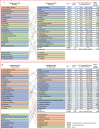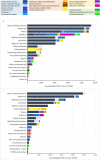Mongolia health situation: based on the Global Burden of Disease Study 2019
- PMID: 34983445
- PMCID: PMC8729000
- DOI: 10.1186/s12889-021-12070-3
Mongolia health situation: based on the Global Burden of Disease Study 2019
Abstract
Background: Over the past few decades, economic, political, and social changes have directly and indirectly affected the health of the Mongolian population. To date, no comprehensive analysis has been conducted on the burden of diseases in this country. Thus, we aimed to describe the leading causes of death and disabling conditions and their trends between 1990 and 2019 in the Mongolian population.
Methods: We used the data from the Global Burden of Disease (GBD) 2019 study. In the current study, we examined life expectancy at birth, healthy life expectancy, the 20 leading causes of death, years of life lost (YLLs), years lived with disability (YLDs), disability-adjusted-life-years (DALYs), and the contribution of major risk factors to DALYs in Mongolia.
Findings: The life expectancy at birth in Mongolia has gradually increased since 1995 and reached 63.8 years for men and 72.7 for women in 2019. The highest increase in the age-standardised death rate between 1990 and 2019 occurred in alcohol use disorders (628.6%; 95% UI 10.0-1109.6) among men, and in liver cancer (129.1%; UI 65.3-222.4) among women. Ischaemic heart disease and stroke showed the highest rates of death, YLLs, and DALYs among both men and women. In 2019, the highest age-standardised rates of DALYs were attributable to high systolic blood pressure and dietary risks.
Interpretation: Although Mongolia saw substantial improvements across many communicable diseases, maternal and neonatal disorders, and under-5 mortality between 1990 and 2019, non-communicable diseases remained leading causes of mortality. The mortality from the most preventable causes such as injury, alcohol use, and dietary risks remain substantially high, suggesting that individual and social efforts are needed to tackle these diseases. Our analyses will support the development of policy priorities and action plans in multiple sectors to improve the overall health of the Mongolian population.
Funding: Bill & Melinda Gates Foundation.
© 2021. The Author(s).
Conflict of interest statement
All authors declare they have no competing interests to declare.
Figures




Similar articles
-
Global incidence, prevalence, years lived with disability (YLDs), disability-adjusted life-years (DALYs), and healthy life expectancy (HALE) for 371 diseases and injuries in 204 countries and territories and 811 subnational locations, 1990-2021: a systematic analysis for the Global Burden of Disease Study 2021.Lancet. 2024 May 18;403(10440):2133-2161. doi: 10.1016/S0140-6736(24)00757-8. Epub 2024 Apr 17. Lancet. 2024. PMID: 38642570 Free PMC article.
-
The burden of diseases, injuries, and risk factors by state in the USA, 1990-2021: a systematic analysis for the Global Burden of Disease Study 2021.Lancet. 2024 Dec 7;404(10469):2314-2340. doi: 10.1016/S0140-6736(24)01446-6. Lancet. 2024. PMID: 39645376 Free PMC article.
-
Burden of disease scenarios for 204 countries and territories, 2022-2050: a forecasting analysis for the Global Burden of Disease Study 2021.Lancet. 2024 May 18;403(10440):2204-2256. doi: 10.1016/S0140-6736(24)00685-8. Lancet. 2024. PMID: 38762325 Free PMC article.
-
Global, regional, and national burden of 12 mental disorders in 204 countries and territories, 1990-2019: a systematic analysis for the Global Burden of Disease Study 2019.Lancet Psychiatry. 2022 Feb;9(2):137-150. doi: 10.1016/S2215-0366(21)00395-3. Epub 2022 Jan 10. Lancet Psychiatry. 2022. PMID: 35026139 Free PMC article.
-
Global burden of disease attributable to mental and substance use disorders: findings from the Global Burden of Disease Study 2010.Lancet. 2013 Nov 9;382(9904):1575-86. doi: 10.1016/S0140-6736(13)61611-6. Epub 2013 Aug 29. Lancet. 2013. PMID: 23993280 Review.
Cited by
-
[Lip and oral cancers in East Asia from 1990 to 2035: trends of disease burden and future projections].Nan Fang Yi Ke Da Xue Xue Bao. 2025 Jul 20;45(7):1554-1562. doi: 10.12122/j.issn.1673-4254.2025.07.23. Nan Fang Yi Ke Da Xue Xue Bao. 2025. PMID: 40673319 Free PMC article. Chinese.
-
Trends in concurrent tobacco use and heavy drinking among individuals 15 years and older in Mongolia.Sci Rep. 2022 Oct 5;12(1):16639. doi: 10.1038/s41598-022-21094-7. Sci Rep. 2022. PMID: 36198896 Free PMC article.
-
The burden of liver cancer in Mongolia from 1990-2019: a systematic analysis for the Global Burden of Disease Study 2019.Front Oncol. 2024 Sep 3;14:1381173. doi: 10.3389/fonc.2024.1381173. eCollection 2024. Front Oncol. 2024. PMID: 39290241 Free PMC article.
-
Prevalence of Type 2 Diabetes in Mongolia: Results from Population-Based Survey Compared with 1999 Study.Diabetes Metab Syndr Obes. 2023 Jun 21;16:1833-1846. doi: 10.2147/DMSO.S413320. eCollection 2023. Diabetes Metab Syndr Obes. 2023. PMID: 37366487 Free PMC article.
-
Epidemiology of pneumonia in hospitalized adults ≥18 years old in four districts of Ulaanbaatar, Mongolia, 2015-2019.Lancet Reg Health West Pac. 2022 Sep 10;30:100591. doi: 10.1016/j.lanwpc.2022.100591. eCollection 2023 Jan. Lancet Reg Health West Pac. 2022. PMID: 36419739 Free PMC article.
References
-
- Integrated statistical database of Mongolia. Population. http://www.1212.mn/stat.aspx?LIST_ID=976_L03 (Accessed 2 Sept 2019).
-
- Tsilaajav T, Ser-Od E, Baasai B, Byambaa G, Shagdarsuren O. Mongolia Health System Review. Manila: World Health Organization, Regional Office for the Western Pacific; 2013.
-
- National Center for Health Development of Mongolia: Health Indicator 2019. Ulaanbaatar 2020. www.hdc.gov.mn/media/uploads/2021-05/Health_Indicator_2019_ENG.pdf. Accessed 31 Jan 2021.
Publication types
MeSH terms
Grants and funding
LinkOut - more resources
Full Text Sources
Medical
Miscellaneous

